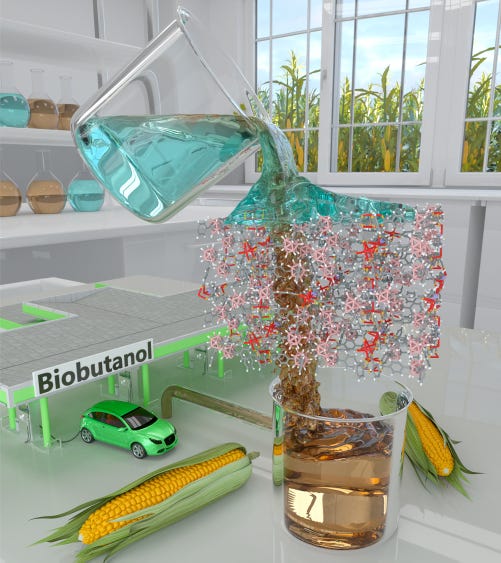May 8, 2020

Farmers following the renewable fuels market may have heard of biobutanol. This product, which can be made from plant oils or other biomass sources, is a renewable equivalent of butanol. Biobutanol has almost the same energy density as gasoline; can be moved through pipelines, like most commercial fuels; and is a solid candidate as a renewable fuel source not only for cars or pickups, but also jet engines.
Recently an international research collaboration, which included scientists from Oregon State University, announced an important step in the commercially viable manufacture of biobutanol. The fuel is a promising future alternative to fossil fuels.
The key breakthrough is a new metal organic framework, or MOF. This substrate can efficiently separate biobutanol from the broth of fermented biomass needed for the fuel’s production. The findings of this research were published recently in the Journal of the American Chemical Society.

NEW MATERIAL: Oregon State University chemists have developed a material that can filter out biobutanol — an advanced renewable fuel — more easily than distillation. This illustration is a representation of the process. (Courtesy of OSU)

The next step for the researchers is to partner with industry to try to scale up the separation method using the new MOF. If it scales up well, this could be a key milestone on the road to ending reliance on fossil fuels.
Kyriakos Stylianou, chemistry research, OSU College of Science, explains that biofuels are a sustainable and renewable fuel alternative, and biobutanol has recently emerged as an attractive option compared to bioethanol or biodiesel, “but separating it from the fermentation broth has been a significant obstacle on the way to economically competitive manufacturing.
A little background
Butanol, also known as butyl alcohol, is more closely related to gasoline than ethanol and can be synthesized from petroleum or made from biomass. Bioethanol — ethyl alcohol — is a common biofuel additive, but it has less energy per gallon than gasoline.
The process for creating biobutanol is acetone-butanol-ethanol fermentation. It yields a watery broth that has, at most, 2% butanol by weight. The key is a separation tool that can work well in an aqueous environment, and also in the presence of organic solvents. In this case, the solvent is acetone, which is a key ingredient in products like nail polish remover and paint thinner.
Stylianou and colleagues at universities in Switzerland, China, the United Kingdom and Spain synthesized a novel metal organic framework. The material is based on copper ions and carborane-carboxylate ligands. This new material can pull butanol from the fermentation broth by adsorption, which is the process of trapping material in the MOF. This approach is more efficient than distillation or other existing methods; and the MOF is stable in organic solvents, in hot water and in both acid and base solutions.
Boosting the efficiency of biobutanol retrieval from the fermentation material makes the product more commercially viable. “Biofuels can augment energy security and supply, and also can be a big part of an energy plan that actually captures and stores carbon — which would be huge for meeting targets for combating climate change,” Stylianou says.
He adds that biobutanol is better than bioethanol for many reasons, including that it’s almost as energy-dense as gasoline and mixes well with gasoline. Also, biobutanol can also potentially replace synthetic butanol as an essential precursor for a range of industrial chemicals.
Oregon State University, Mineco, the government of Catalonia (Generalitat de Catalunya), the National Natural Science Foundation of China and the UE Feder Program supported this research.
The biobutanol study is Stylianou’s second major MOF-related paper of the past few months. In December, Nature published research by Stylianou involving a MOF that can scrub carbon dioxide from smokestack emissions.
That next step on that front will also involve scaling: how to make and test the MOFs on a large enough scope to tackle industrial CO2 emissions.
Source: Oregon State University, which is solely responsible for the information provided and is wholly owned by the source. Informa Business Media and all its subsidiaries are not responsible for any of the content contained in this information asset.
You May Also Like




